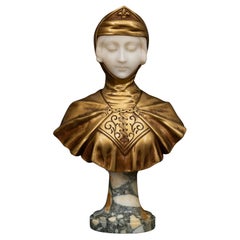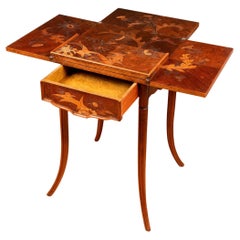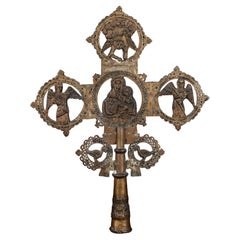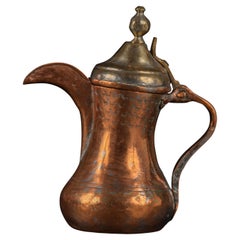Want more images or videos?
Request additional images or videos from the seller
1 of 8
1927 Gelas Double-Table Mandolin, Numbered (5947) and Stamped
$3,548.53List Price
About the Item
- Dimensions:Height: 21.26 in (54 cm)Width: 6.3 in (16 cm)Depth: 2.76 in (7 cm)
- Materials and Techniques:
- Place of Origin:
- Period:
- Date of Manufacture:1927
- Condition:Wear consistent with age and use.
- Seller Location:Ixelles, BE
- Reference Number:1stDibs: LU10116242387392
About the Seller
No Reviews Yet
Vetted Professional Seller
Every seller passes strict standards for authenticity and reliability
1stDibs seller since 2024
Authenticity Guarantee
In the unlikely event there’s an issue with an item’s authenticity, contact us within 1 year for a full refund. DetailsMoney-Back Guarantee
If your item is not as described, is damaged in transit, or does not arrive, contact us within 7 days for a full refund. Details24-Hour Cancellation
You have a 24-hour grace period in which to reconsider your purchase, with no questions asked.Vetted Professional Sellers
Our world-class sellers must adhere to strict standards for service and quality, maintaining the integrity of our listings.Price-Match Guarantee
If you find that a seller listed the same item for a lower price elsewhere, we’ll match it.Trusted Global Delivery
Our best-in-class carrier network provides specialized shipping options worldwide, including custom delivery.You May Also Like
20th Century French Hand Painted Ceramic Ashtray by Longwy Stamped and Numbered
Located in Sofia, BG
Hand painted oval ceramic ashtray with small covered part in the middle. The top of it is decorated with flowers and leaves in bright colours. There are numerous stamps and numbers o...
Category
Early 20th Century French Ashtrays
Materials
Ceramic
$307
H 1.97 in W 3.55 in D 8.67 in
Mandolin Singing Bird Automaton Music Box
Located in New Orleans, LA
This exceptional singing bird cylinder music box is a wonder of Austrian mechanical ingenuity. Not only does it play a selection of classical airs with remarkable tone and clarity, but its lush sound is accompanied by a colorful, singing bird automaton...
Category
Antique 19th Century Austrian Other Musical Instruments
Materials
Satinwood
19th Century Mandolin Cylinder Music Box
Located in Dublin 8, IE
19th Century mandolin cylinder music box in an ebonised rosewood case featuring boxwood floral inlaid cartouche and crossbanding. With brass musical movement including a rolling cyli...
Category
Antique 19th Century European Decorative Boxes
Materials
Brass
Piero Fornasetti, mandolins cigars Box, Milan Italy, ca. 1960s
By Piero Fornasetti
Located in Firenze, IT
Piero Fornasetti, mandolins cigars Box
Milan Italy, ca. 1960s
Wood and hand refined lacquered aluminium
H 4 cm x 8 × 20 cm
Label not present
Conditions: good consistent with age...
Category
Vintage 1960s Italian Mid-Century Modern Cigar Boxes and Humidors
Materials
Metal
Antique Wrench Set Box c.1918-1927
Located in San Francisco, CA
ABOUT
An antique wrench set box used to store a socket set. Box is constructed with dovetail joints, steel brackets and has original brass label.
S...
Category
Early 20th Century Industrial Decorative Boxes
Materials
Brass
Florentine Stamps Box
Located in Clearwater, FL
A hand painted wooden box from Italy, adorned with traditional gold leaf and soft ivory tones. Designed for holding stamps or other small treasures, it features classic Florentine sc...
Category
Vintage 1970s Italian Decorative Boxes
Materials
Wood
Antique German Sterling Silver Sugar Box (1927)
Located in Jesmond, Newcastle Upon Tyne
An exceptional, fine and impressive antique German sterling silver sugar box modelled in the form of a partridge; part of our collection of s...
Category
Vintage 1920s German Decorative Boxes
Materials
Sterling Silver
Antique English Art Deco Sterling Silver Box, 1927
By Henry Matthews
Located in New York, NY
Art Deco sterling silver box. Made by Henry Matthews in Birmingham in 1927. Square with straight and plain sides. Cover hinged, tabbed, and chamfered. On top parcel gilt with engine-...
Category
Vintage 1920s British Art Deco Decorative Boxes
Materials
Sterling Silver
Rare Austrian Silver and Enamel Stamp Box with Mouse and Seed Pearls
Located in Long Island City, NY
Rare Austrian Silver and Enamel Stamp Box with Mouse and Seed Pearls
The Quality is Fantastic, so well executed, in great condition this item is ready to use.
Marked 84 and then ov...
Category
Antique 19th Century Austrian Snuff Boxes and Tobacco Boxes
Materials
Silver, Enamel
Tiffany Studios New York Bronze Doré and Abalone Stamp Box
By Tiffany Studios
Located in South Bend, IN
A gorgeous Art Nouveau or Art Deco period gilt bronze and inlaid abalone stamp box
By Tiffany Studios
New York, USA, early 20th century
Measures: 4"W x 2.13"D x 1.25"H.
Good orig...
Category
Early 20th Century American Arts and Crafts Decorative Boxes
Materials
Bronze
More From This Seller
View AllGUSTAVE VAERENBERGH (1873-1927) Bust in Alabaster and Gilt Bronze "JEANNE D'ARC"
By Gustave van Vaerenbergh
Located in Ixelles, BE
GUSTAVE VAERENBERGH (1873-1927) Bust in Alabaster and Gilt Bronze "JEANNE D'ARC" (end 19th century-early 20th century)
- THE WORK:
The alabaster and gilt bronze bust of Joan of A...
Category
Antique Late 19th Century French Art Nouveau Busts
Materials
Alabaster, Bronze
Émile Gallé Game Table in Walnut and Marquetry of Veneered Wood with a Floral
By Émile Gallé
Located in Ixelles, BE
"Émile Gallé Game Table in Walnut and Marquetry of Veneered Wood with a Floral Thistle Motif (c. 1895).
Émile Gallé’s game table is an exceptionally refined work of art, perfectly e...
Category
Antique 1880s French Art Nouveau Secretaires
Materials
Nutwood
Ethiopian Procession Cross: A Sacred Heritage and Craftsmanship
Located in Ixelles, BE
Ethiopian Procession Cross: A Sacred Heritage and Craftsmanship.
Structure and Composition: This finely crafted Ethiopian procession cross is rich in iconographic detail. Constructed from metal, likely bronze or brass, it features a complex structure with several decorative elements.
- Central Part:
• Madonna and Child: At the heart of the cross is a depiction of the Virgin Mary holding the Child Jesus. This central image is framed within a circle adorned with openwork motifs and small inlays that appear to be precious stones or colored glass pieces.
Arms of the Cross:
• Angelic Musicians: Each lateral arm of the cross features an angelic musician, playing instruments and depicted in a flying position. The angels are finely detailed, with spread wings and carefully sculpted garments.
• Cherub: At the apex of the cross, a cherub is depicted, a celestial being with multiple wings and surrounded by cloud-like motifs.
• Bird Motifs: The lower extremities of the cross are adorned with bird motifs, likely doves, symbolizing peace and the Holy Spirit, placed within openwork circles.
Base and Handle:
• Engraved Base: The base of the cross, which serves as a handle, is also richly engraved with floral and geometric motifs, providing a sturdy and decorative grip for processions.
History of Ethiopian Procession Crosses
Origins and Evolution: Ethiopian procession crosses have a long history, dating back to the introduction of Christianity to Ethiopia in the 4th century under King Ezana. Influenced by Coptic and Byzantine traditions, these crosses evolved to adopt a distinctive style unique to Ethiopia.
- Characteristics:
• Style and Iconography: Ethiopian crosses...
Category
Antique 19th Century Ethiopian Primitive Tribal Art
Materials
Brass
Dallah Coffee Pot: A Masterpiece of Arab Hospitality and Art
Located in Ixelles, BE
Dallah Coffee Pot: A Masterpiece of Arab Hospitality and Art
The "Dallah" coffee pot we see here is a magnificent piece representative of Arab culture. Likely made of copper, it fea...
Category
Early 20th Century Unknown Islamic Serving Pieces
Materials
Copper
Egyptian Dallah Coffee Pot: A Symbol of Hospitality and Cultural Richness
Located in Ixelles, BE
Egyptian Dallah Coffee Pot: A Symbol of Hospitality and Cultural Richness.
- Object:
A dallah (Arabic: دلة) is a traditional Arab coffee pot used to prepare and serve coffee in the...
Category
20th Century Egyptian Egyptian Serving Pieces
Materials
Brass
Bronze sculpture "The Siren" by Guy Degrenne (??-??)
Located in Ixelles, BE
Description of the Artwork:
This captivating sculpture depicts a slender siren emerging from its base of rough stone in a vertical thrust, with her arms raised and crossed above her...
Category
20th Century Belgian Modern Figurative Sculptures
Materials
Metal
Recently Viewed
View AllMore Ways To Browse
Antique Stamps
Stamp Box
Antique Number Stamps
Antique Swift
Used String Instruments
Antique Mandolin
Antique Birdseye Maple Table
Antique String Instrument
Half Doll
Leather Storage Box
Mid Century Stone Black And White Box Boxes
Pietra Dura Panels
Square Wood Box
Swedish Box 18th
T Boone Pickens
Antique Strongbox
Beautiful Wood Boxes
Boulle Box



